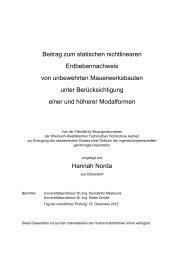Ion Beam Treatment of Functional Layers in Thin-Film Silicon Solar ...
Ion Beam Treatment of Functional Layers in Thin-Film Silicon Solar ...
Ion Beam Treatment of Functional Layers in Thin-Film Silicon Solar ...
Create successful ePaper yourself
Turn your PDF publications into a flip-book with our unique Google optimized e-Paper software.
2.2 Transparent conduct<strong>in</strong>g oxide<br />
ZnO:Al films are also characterized by low material density, relatively high resistivity<br />
and high HCl etch rate.<br />
2.2.4.4 As-grown rough ZnO films<br />
As-grown rough ZnO:B films have been prepared by several deposition techniques such as<br />
low pressure chemical vapor deposition (LPCVD) [85, 86] and expand<strong>in</strong>g thermal plasma<br />
CVD [87]. As already discussed, magnetron sputtered ZnO films tend to exhibit c-axis<br />
preferred orientation. Compared with those CVD prepared films, sputter deposited ZnO<br />
films generally exhibit smaller lateral features. Thus, the flat sputtered ZnO:Al films<br />
have to be etched <strong>in</strong> wet chemicals <strong>in</strong> order to provide a light scatter<strong>in</strong>g effect at the<br />
ZnO/Si <strong>in</strong>terface. The replacement <strong>of</strong> wet chemical etch<strong>in</strong>g by dry etch<strong>in</strong>g or as-grown<br />
rough ZnO seems very attractive for <strong>in</strong>dustry process, because the vacuum break can<br />
be avoided. There have been many attempts to sputter as-grown rough ZnO films by<br />
magnetron sputter<strong>in</strong>g [11–15]. In the follow<strong>in</strong>g, the literature related to as-grown rough<br />
ZnO films by magnetron sputter<strong>in</strong>g are briefly reviewed.<br />
Generally, as-grown rough ZnO surfaces were sputtered at very high pressures or with<br />
water vapor. It was reported by M<strong>in</strong>ami et al. and Sato et al. that wedge-like surface<br />
features were sputtered on undoped ZnO and ZnO:Al films with gas pressure between<br />
3 and 10 Pa and substrate temperature <strong>of</strong> about 300 ◦ C. The sheet resistance <strong>of</strong> these<br />
films is approximately 1.8 Ω at thickness <strong>of</strong> 3 µm [11, 13, 14]. Nakada et al. added H 2 O<br />
together with Ar gas <strong>in</strong> the sputter<strong>in</strong>g chamber. With <strong>in</strong>creas<strong>in</strong>g H 2 O partial pressure,<br />
the columnar structure which can be seen <strong>in</strong> ZnO films deposited <strong>in</strong> pure Ar disappeared.<br />
The maximum lateral feature size for ZnO films grown <strong>in</strong> pure H 2 O was approximately<br />
1 µm. With Al dop<strong>in</strong>g, the change <strong>of</strong> surface morphology was not significant. The<br />
mobility <strong>of</strong> the ZnO:Al film sputtered <strong>in</strong> mixed water vapor and Ar, however, is quite<br />
low 3 cm 2 /Vs. After anneal<strong>in</strong>g <strong>in</strong> vacuum, the mobility can be improved to 9 cm 2 /Vs.<br />
As a result, the electrical properties <strong>of</strong> these ZnO:Al films are not sufficient for the front<br />
contact <strong>in</strong> solar cells. Similar results were found by Kluth et al. [16]. As-grown rough<br />
ZnO:Al films were obta<strong>in</strong>ed as long as the fraction <strong>of</strong> water vapor <strong>in</strong> the Ar gas is larger<br />
than 1% and the film thickness is larger than 500 nm. However, these films also suffered<br />
high resistivity. It was also noted by the above authors that gas mixtures such as Ar/O 2<br />
and Ar/H 2 do not lead to as-grown rough ZnO:Al films.<br />
Additionally, it was found by Krantz et al. that add<strong>in</strong>g N 2 <strong>in</strong>to the sputter chamber,<br />
as-grown rough ZnO:Al films were obta<strong>in</strong>ed by reactive sputter<strong>in</strong>g [88]. The surface<br />
lateral size was <strong>in</strong>creased from 50 nm to 500 nm as the flow rate <strong>of</strong> N 2 was <strong>in</strong>creased<br />
from 0 to 10 sccm. The sheet resistance <strong>of</strong> the film, however, was <strong>in</strong>creased from 4 to<br />
4277 Ωcm due to the large decreas<strong>in</strong>g mobility.<br />
To summarize, as-grown rough ZnO:Al films have been deposited by magnetron sputter<strong>in</strong>g<br />
at very high pressure or by add<strong>in</strong>g water vapor or N 2 to the sputter process.<br />
The as-grown rough ZnO:Al films, however, tend to exhibit low mobility as well as high<br />
resistivity, mak<strong>in</strong>g them unlikely to be applied <strong>in</strong> solar cells. One important focus <strong>of</strong><br />
this work is the sputter<strong>in</strong>g <strong>of</strong> as-grown rough ZnO:Al films without strongly deteriorated<br />
electrical properties.<br />
33















